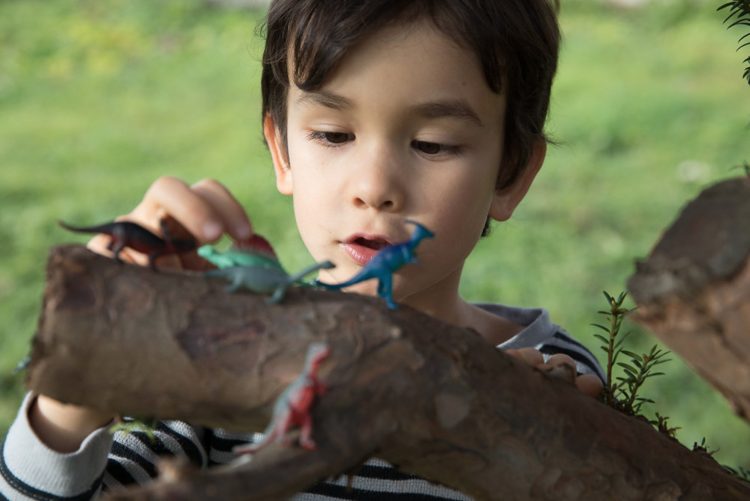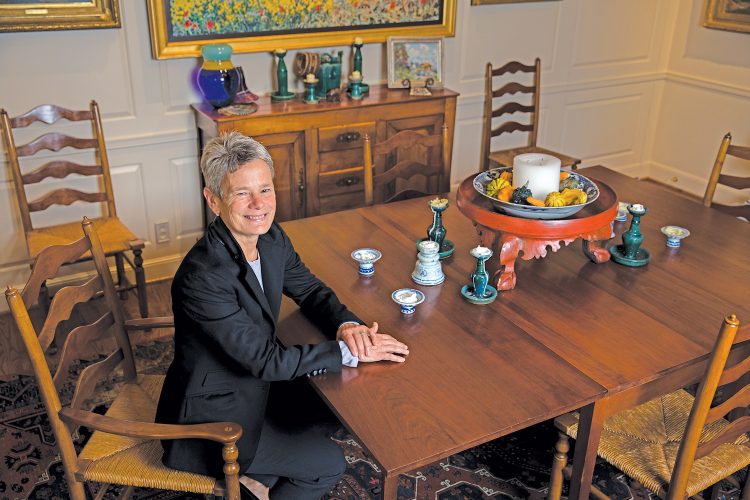“Dear Burke Musen,” start the words in green crayon. “Here is your doller. Use this doller to find the yturantis bownes. Love Max.”
Once the folks at the museum realized “bownes” were “bones,” they quickly figured “yturantis” must be “Tyrannosaurus.”
For Max Nichols, 6, the world is a feast of Legos, stars and constellations, Spiderman, the family cat, picture books and, of course, dinosaurs. “Dinosaurs are incredible,” he says during a recent interview as he sprawled on the floor of his playroom.
“I have loved dinosaurs for a long, long, long, long time,” says Max. How long? “Since I was 3.”
So when his parents were writing gift checks to the animal shelter and Mary’s Place (a resource for homeless women and children), and they asked Max what he would like to give to, his answer really was no surprise: “Dinosaurs!”
“We looked around at where he could do that,” says his mother, Kris Nichols, ’03. “We thought of the UW’s Burke Museum and showed him the website.”
“I was so excited about it, I sent them a note,” says Max. He crafted a letter, adding some stickers and creating a pocket to hold the dollar he took from his piggy bank.
Little did Max know that his heartfelt donation would be one of thousands supporting the UW’s most ambitious fundraising campaign to serve the public, enrich student experience, and expand the good the University can do around the world.
***
Already more than $3 billion toward a $5 billion goal, the campaign supports the University’s work and impact in every way imaginable, paying for students to go on archaeological digs, helping teachers educate Washington’s next generations, and exploring ways to help people live fuller, safer, healthier lives.
And the campaign will allow the University to build a new home for the Burke Museum, as well as a desperately needed second building for Computer Science and Engineering and a refurbishing of Parrington Hall, the second-oldest classroom building on campus.
The campaign, which is called “Be Boundless—For Washington, For the World,” will also improve access, affordability and quality of education for Washington’s students.
Philanthropy at the University is nothing new; it dates to the 1861 donation of 8 acres on the outskirts of the settlement of Seattle. In the ensuing years, gifts from donors, along with volunteer labor from students and faculty, helped create the grounds of the campus, which had moved north to 538 acres in the Montlake neighborhood. In 1926, Horace C. Henry, a railroad and real estate investor, donated his art collection and $100,000 to build a museum (Washington’s first art museum) to house it.

Dinosaur aficionado and Burke Museum donor Max Nichols, 6.
Whenever they saw a need, Washingtonians stepped up. In 1936, residents of the region, though in the throes of the Great Depression, raised $5,000, one dollar at a time, to send the cash-strapped Husky rowing team to the Olympics in Berlin. Three decades later, the UW Alumni Association started the University’s first official private philanthropic effort, the UW Alumni Fund, raising money for scholarships by calling names out of the Tyee yearbook.
In 1968, the University began fundraising in earnest. Artie Buerk, ’58, was hired to lead this effort. It paid off by bringing in about $20 million a year for scholarships, endowments and capital projects.
In 1987, the UW launched the Campaign for Washington, its first official campaign. The following year, the UW Foundation was formed, bringing together alumni, local and regional leaders and University officials. By 1992, it had raised $267 million, including $10 million from Paul Allen to help create the Allen Library, named for his father, once associate director of libraries at the UW. Starting in 2000, the second campaign, Campaign UW: Creating Futures, brought in a staggering $2.68 billion over its eight-year run. The campaign began with a $2 billion goal. Those gifts included William H. Gates Hall to house the law school building and PACCAR Hall for the business school.
***
Maggie Walker, ’74, ’87, volunteered with the campaign of the 2000s, helping raise money for the College of Arts and Sciences. Due to the limits of state salaries, the college was losing professors to public and private schools across the country.
So the dean of Arts and Sciences prioritized 100 new professorships to augment salaries as well as to provide dollars for books, equipment and research support. The campaign actually resulted in more than 120 professorships, allowing the University to recruit and retain a sizable group of talented teachers.
Walker’s efforts can be felt across campus, from the humanities to hard science. Hosting a dinner party nearly a decade ago, she and her husband, Doug, invited UW researchers working on green cities to meet with business leaders. The guests quickly realized that the UW’s research wasn’t connecting to the community needs. “It was kind of a disaster,” says Walker. “You couldn’t get an environmental science degree here. It was clear there was a pent-up demand for people with those skills.”
That was one of the first conversations leading to the development of the College of the Environment, which brought together 50 programs and 400 faculty already working in earth, ocean and space sciences.

Maggie Walker, ’74, ’87, hosted a dinner party that sparked the conversation for forming the UW College of the Environment. Today she is one of the volunteers leading the fundraising effort for the new college.
This time around, Walker, who has a degree in history, is serving as fundraising co-chair for the College of the Environment. Things are different. “At the time of the last campaign, we had to make the case for private support,” she says. “Now people understand the need.”
The $5 billion goal is the largest of any public university in the country. In 2014, UC Berkeley reached its $3 billion goal the same year UCLA set its sights on $4.2 billion. The University of Michigan has raised $3.6 billion toward its $4 billion goal. “This campaign is ambitious,” says UW President Ana Mari Cauce. “It has to be, because it’s about creating the future we all want.”
The new campaign is an opportunity for the UW to imagine and plan how it should and could be growing its service to humankind, says Mike Halperin, ’85, ’90, an ER doctor who with his wife, Jodi Green, are two of the campaign’s eight general chairs.
It’s also about highlighting the work coming out of the University, much of which he and other volunteers believe sometimes goes unrecognized. “People around the world, professors at Stanford and the Sorbonne, know more about this place than we do in this community,” he says. “This campaign is essential for sharing what it does.”
Volunteers like Bob, ’65, ’68, and Micki Flowers, ’73, also two of the campaign’s general co-chairs, joined the campaign because of their experiences as students. “We found inspiring mentors and lifelong friends at the UW, and we want to help students—particularly those from underserved communities—have those same advantages,” says Bob Flowers, an Evans School alum and student athlete who became one of the region’s first African American banking executives. He and Micki, the first woman African American broadcaster at KIRO, have a more personal connection to the University: They met and had their first date at the HUB.
***
“When a young person talks about what transformed them in their college education, they never say it was in Kane Hall,” says Lisa Graumlich, dean of the College of the Environment. “It’s the experience that puts them in the real world.”
Thanks to scholarships and research support, students who might not otherwise afford to can do fieldwork—on the ocean, in the forests, up in Alaska—experience that allows them the opportunity to do real research and learn as they go.
Private support also gives students and faculty the space to dream, Graumlich says. “When a student comes in with a new risk-taking and innovative idea, we’re enabling them to pursue it. We need that. Sometimes it’s about one faculty member. Sometimes it’s about a big project.”
A major focus in the campaign centers around population health, a broad, cross-disciplinary approach to understand and address the interrelated conditions that affect the health and well-being of people everywhere—from neighborhoods, to cities, to nations. With a gift of $210 million in late October, the Bill & Melinda Gates Foundation became the first to endorse and catalyze this vision through a new building to house the Department of Global Health, the Institute for Health Metrics and Evaluation (IHME), and portions of the School of Public Health. The gift is one the largest contributions in the history of the UW.
Of course, there are myriad other projects in need of support. For example, public radio station KUOW wants to improve the social impact of its reporting. The Foster School of Business seeks to expand its Young Executives of Color program to help regional high school students find their way to college. And biochemistry professor David Baker and his team at the Institute for Protein Design seek support to accelerate their work designing proteins that can act like medicines and materials. In effect, they’re creating new, more precise drugs to protect against viruses from influenza to HIV.

Biochemist David Baker and his team are designing proteins that act as medicines and could combat deadly viruses.
The effort touches every part of every campus. UW Tacoma is raising money with community partners to tackle the achievement gap for schoolchildren. The School of Nursing is looking for donations to complement $4 million in state funding to update and expand its simulation lab. UW Libraries seek support for the processing and preservation of Seattle’s historical architectural drawings. And the law school wants to create 52 new $10,000 annual scholarships to attract the most talented students from underrepresented populations.
“In the past, we spoke of private giving as our margin of excellence,” says Robert Stacey, dean of Arts and Sciences. “Today it is our lifeblood.”
Gifts to the campaign, including annual gifts, do not replace essential state support, but they do enable the UW to continue to provide its best to the students and people of Washington.
Small and large, every goal and project fulfills a compelling need. A single professorship like the one in the name of beloved alumna and children’s author Beverly Cleary, ’39, enables the Information School to recruit a nationally recognized expert in children’s literature and ethnic diversity like Michelle Martin.
On the larger side, a new Life Sciences Complex will house the Department of Biology, the University’s biggest major, with 600 students earning degrees each year. The goal of $54 million in private support will complete the 20,000-square-foot greenhouse, finish the fifth floor of the building and help expand the faculty to better meet the research and teaching needs of the College of Arts and Sciences.
***
Last summer, Max’s wish for his $1 gift came true. While out on a walk, two alumni volunteering at a UW field school in Montana found more “bownes.” The rare fossil discovered by Jason Love ’92, ’07, and Luke Tufts, ’91, a 66-million-year-old T. rex head, excited dinosaur fans around the world. Between the first and second bedtime book, Max’s mother checked her Twitter feed and caught news of the find. Max bolted out of bed to write another note.
“Dear Burke,” he wrote. “You finally found a T. rex! Here is another dollar for the exhibit!!”